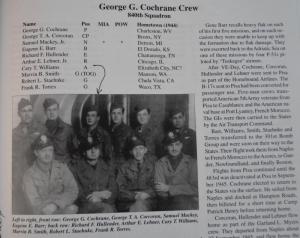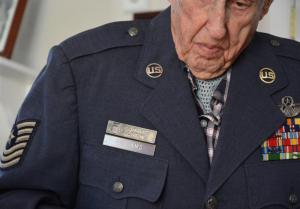Married 70 years, WWII vet, wife ‘become one’
It was an interview less than a week before Veterans Day, but even if the day had been six months away, WWII veteran Cary Williams would still be ready to wear his decades-old, Air Force-issued formal blues.
“It’s always hanging in his closet, just in case,” said Hilda, Cary’s wife. The Lewes couple celebrated 72 years of marriage in September.
Cary, who turns 95 on Christmas Day, doesn’t waste any time putting his jacket on. He’s proud that he still fits into it. Hilda’s said she’s proud too. If anything, she said, it’s getting to be a bit big.
“Just as long as he stays above 130 pounds, he looks good in it,” Hilda said, looking over to him. “Right, stay above 130 pounds.” Cary shook his head, “Yes,” acknowledging a comment he’s heard many times before.
Cary had his larynx removed in 1977 because of cancer, and it all but extinguished his voice. Hilda said Cary, through therapy, was able to talk, but in the last two years the volume has really diminished.
“You have to be a really good listener to understand him,” said Hilda. “Most of the time you can get what he’s trying to say.”
Hilda may be the voice of the two, but she said she’s legally blind, so Cary is their eyes.
“Over the years, we’ve become one,” said Hilda, who turns 90 Dec. 8.
Cary may not easily talk about his days in WWII, but he was quick to show off a book recognizing and documenting the acts of bravery by American service members during the war. There’s a full page dedicated to his group – it’s called the George G. Cochrane Crew of the 840th Squadron.
According to the book, there were 10 crew members, from 10 different states – West Virginia, New York, Missouri, Kansas, Tennessee, Illinois, North Carolina, Washington, California and Texas.
The majority of the squadron assembled in Lincoln, Neb., and then transferred to Tennessee in June 1944. They went through 10 weeks of intense training before returning to Lincoln, where they were issued combat clothing and equipment.
From Lincoln, the crew took a train to Camp Patrick Henry, Va. Along with 15 other crews destined for the 483rd Bomb Group, Cary and his crew took an ocean liner across the Atlantic, arriving in Naples, Italy, in October 1944. Three days later they were assigned to the 483rd, and by early November the George Cochrane Crew was flying combat missions.
The crew’s targets included Munich, Vienna, Blechhammer, Augsburg, Ruhland, Innsbruck, Wiener Neustadt, Wiener Neudorf, the Po Valley, Prague, Landshut, Salzburg and Moosbierbaum.
Cary and his crew members were in Europe during VE Day – Victory in Europe Day, May 8, 1945. Soon after, according to the book, Cary was transferred to the 301st Bomb Group and sent back to the United States, landing in Boston.
Cary is one of the few members of the 840th Squadron still alive. At the bottom of the page in the book, he’s written down all the names of his squadron members who have died, starting with Cochrane himself in 1983. Some of the men, like Cary, enjoyed long careers in the Air Force, but just as the crew came from a variety of states, some of the men went on to other professions as an electrician, IBM employee, geologist, Sears employee, court interpreter and U.S. Post Office employee.
During his wartime service, Cary was a ball turret gunner for the B17 airplanes his squadron flew. He said in addition to rattling off round after round of .50-caliber bullets, he would let the plane’s pilot know if there was an enemy plane making its way unseen.
“I would say, ‘There’s a German plane coming, everybody be careful,’” said Cary, who like a good teammate recognized all his crew members had an important job. “Every position was challenging.”
Scattered through the house are memories of Cary’s service to his country. Hanging on one wall is a picture of him as a first-year soldier, when he first entered the Air Force. On another wall is a framed Meditteranian edition of Stars and Stripes with an all-caps headline taking up the front page that reads, “IT’S ALL OVER OVER HERE.” Miniature versions of B17s are on the ready to show off. Even the license plate on Cary’s small pickup says B17 GNR.
After WWII, Cary went to North Carolina State to get his degree and then reentered the Air Force in February of 1951. As many military families do, Cary, Hilda and their son Gregory traveled from base to base throughout Cary’s military career. They ended up in Dover, with Cary working as an engineer on some of the first versions of the C-141 Starlifters. Cary retired with 22 years of service as a Master Sergeant.
The whole time, Hilda was by his side.
“I was an Air Force wife,” she said with a smile.
After his retirement from the Air Force, Cary became a realtor in Dover while Hilda worked for years at Wesley College as an administrative coordinator. When talking with the couple, it’s easy to see the person they miss most is their son, who died at age 53 after battling multiple sclerosis. “He was kind and good,” said Hilda.
Gregory was an attorney, but he was also interested in genealogy. Before he died he was able to dig into his family’s background. As the couple moves into seven decades of marriage and they each move into nine decades of life, Hilda said it’s interesting to think about how both of them will have lived longer than any other family member from either of their families.
“For me, talking about age isn’t a bad thing,” she said. “It really is a milestone.”





















































